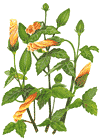Latin Names
Abelmoschus moschatus Malvaceae /
Hibiscus abelmoschus
Hibiscus abelmoschus
English Names
Musk Mallow,
Ambrette Plant
Ambrette Plant
Sanskrit Name
Latakasturi,
Gandapura,
Kasturilatika
Gandapura,
Kasturilatika
Hindi Name
Kasturidana,
Muskadana
Muskadana
The plant grows wild all over the Deccan regions, and the hilly regions of Karnataka. It is also found at the foothills of the Himalayas.
A.moschatus is an erect, annual or biennial, hirsute herb. The leaves are polymorphous: the lower, ovate and acute; the upper, palmately 3-7 lobed; the flowers are bright yellow, large, usually solitary and axillary, sometimes in few-flowered racemes; the capsules are ovate, acute and hispid; the seeds are sub-reniform, black and musk-scented. The crushed seeds, on steam distillation, yield a volatile oil, known as musk seed oil or ambrette seed oil.
The oil from the seeds is rich in linoleic acid and contains a-cephalin, phosphatidylserine, its plasmalogen and phosphatidylcholine plasmalogen. The characteristic musk-like odor of the seed oil is mainly due to the presence of a ketone, ambrettelide, a lactone of ambrettolic acid1. The chemical constituents of the essential oil of the seeds are: trans-2-trans-6-farnesyl acetate and ambrettolide, cis-2-cis-6- farnesyl acetate, cis-2-trans-6-farnesyl acetate, ethyl hexadecanate, ethyl laurate and trans-2-trans-6-farnesol2.
The mucilaginous seeds are emollients and demulcents. The mucilage has shown anticomplementary activity in human serum and hypoglycemic activity in mice3.
The seeds are valued medicinally for their diuretic, demulcent and stomachic properties. They are also said to be stimulant, antiseptic, cooling, tonic, carminative and aphrodisiac.
- Guenther, VI, 174; Krishna & Badhwar, loc. cit.; Wehmer, II, 756, West et. al., 201.
- Hort Abstr, 1993, 63, 607.
- Duke, 1985, 1-2; Cravo et. al., Flav & Fragr J, 1992, 7, 65; Chem Abstr, 1989, 111, 146284.


